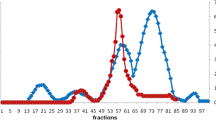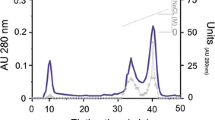Abstract
Aminopeptidases act on N-terminal of proteins and peptides produce free amino acids making an impact on the final flavor of foods. An arginine aminopeptidase (RAP) which preferred to hydrolyze basic amino acids from N-termini of peptides and proteins was purified to homogeneity from white shrimp (Litopenaeus vannamei) muscle. The molecular mass of RAP was estimated as 100 kDa on SDS-PAGE. Peptide mass fingerprinting analysis obtained 95 amino acid residues which was 100 and 77.9 % identical to puromycin-sensitive aminopeptidases from insect and zebrafish, respectively. Optimum pH and temperature of the RAP were 7.0 and 30 °C. RAP rapidly hydrolyzed fluorogenic substrates l-arginine 4-methylcoumaryl-7-amide (Arg-MCA) and Lys-MCA with K m values of 2.7 and 4.9 μM, respectively. The enzyme can be strongly inhibited by puromycin, bestatin, and 1,10-phenanthroline and partially inhibited by ethylenediaminetetraacetic acid (EDTA) and ethylene glycol-bis (2-aminoethylether)-N,N,N′,N′-tetraacetic acid (EGTA). Moreover, the competitive inhibition of puromycin for RAP was confirmed, and K i value was calculated as 0.07 nM. Metal ions of Zn2+ and Mn2+ significantly reactivated the inactive apoenzyme activity dialyzed by EDTA. All these results indicated that the purified enzyme is a metalloaminopeptidase which would possibly contribute to flavor development in shrimp muscle.







Similar content being viewed by others
References
Taylor A (1993) Aminopeptidases: structure and function. FASEB J 7(2):290–298
Kawata S, Takayama S, Ninomiya K, Makisumi S (1980) Purification and some properties of porcine liver aminopeptidase B. J Biochem 88(4):1025–1032
Hersh LB, McKelvy JF (1981) An aminopeptidase from bovine brain which catalyzes the hydrolysis of enkephalin. J Neurochem 36(1):171–178
Mantle D, Lauffart B, McDermott JR, Kidd AM, Pennington RJT (1985) Purification and characterization of two Cl−-activated aminopeptidases hydrolysing basic termini from human skeletal muscle. Eur J Biochem 147(2):307–312
Nishimura T, Okitani A, Kato H (1988) Identification of neutral aminopeptidases responsible for peptidolysis in postmortem rabbit skeletal muscle, vol 52, 9. Agricultural Chemical Society of Japan, Tokyo
Maehashi K, Abe T, Yasuhara T, Yamasato K, Yamamoto Y, Udaka S (2003) Purification and characterization of a novel glutamyl aminopeptidase from chicken meat. Meat Sci 64(2):163–168
Chen X, Wu GP, Cai QF, Liu GM, Osatomi K, Su WJ, Cao MJ (2012) Biochemical characterisation of an aminopeptidase with highest preference for lysine from Japanese flounder skeletal muscle. Food Chem 130(3):679–686
Wu GP, Cao MJ, Chen Y, Liu BX, Su WJ (2008) Leucine aminopeptidase from red sea bream (Pagrus major) skeletal muscle: purification, characterization, cellular Location, and tissue distribution. J Agric Food Chem 56(20):9653–9660
Flores M, Sanz Y, Spanier AM, Aristoy MC, Toldrá F (1998) Contribution of muscle and microbial aminopeptidases to flavor development in dry-cured meat products. In: Contis ET, Ho C-T, Mussinan CJ, Parliment TH, Shahidi F, Spanier AM (eds) Developments in food science, vol 40. Elsevier, Amsterdam, pp 547–557
Toldrá F, Aristoy MC, Flores M (2000) Contribution of muscle aminopeptidases to flavor development in dry-cured ham. Food Res Int 33(3–4):181–185
Hopsu VK, Mäkinen KK, Glenner GG (1966) Purification of a mammalian peptidase selective for N-terminal arginine and lysine residues: aminopeptidase B. Arch Biochem Biophys 114(3):557–566
Mäkinen KK, Mäkinen PL (1978) Purification and characterization of two human erythrocyte arylamidases preferentially hydrolysing N-terminal arginine or lysine residues. Biochem J 175(3):1051–1067
Bogra P, Singh J, Singh H (2009) Purification and characterization of aminopeptidase B from goat brain. Process Biochem 44(7):776–780
Sanz Y, Toldra F (2002) Purification and characterization of an arginine aminopeptidase from Lactobacillus sakei. Appl Environ Microb 68(4):1980–1987
Foulon T, Cadel S, Cohen P (1999) Aminopeptidase B (EC 3.4.11.6). Int J Biochem Cell B 31(7):747–750
Liu BX, Du XL, Zhou LG, Hara K, Su WJ, Cao MJ (2008) Purification and characterization of a leucine aminopeptidase from the skeletal muscle of common carp (Cyprinus carpio). Food Chem 108(1):140–147
Umetsu H, Arai M, Ota T, Kudo R, Sugiura H, Ishiyama H, Sasaki K (2003) Purification and properties of an aminopeptidase from the mid-gut gland of scallop (Patinopecten yessoensis). Comp Biochem Physiol B: Biochem Mol Biol 136(4):935–942
Anonymous (2011) China fisheries yearbook. China Agriculture Press, Beijing
Xue C, Kong F, Li Z, Lin H, Lou W (1997) Formation mechanism of flavoring compounds in Penaeus orientalis. J Fish China 21(1):57–62
Laemmli UK (1970) Cleavage of structural proteins during the assembly of the head of bacteriophage T4. Nature 227(5259):680–685
Mortz E, Krogh TN, Vorum H, Görg A (2001) Improved silver staining protocols for high sensitivity protein identification using matrix-assisted laser desorption/ionization-time of flight analysis. Proteomics 1(11):1359–1363
Lowry OH, Rosebrough NJ, Farr AL, Randall RJ (1951) Protein measurement with the Folin phenol reagent. J Biol Chem 193(1):265–275
Tsou CL (1988) Kinetics of substrate reaction during irreversible modification of enzyme activity. In: Meister A (ed) Advances in enzymology and related areas of molecular biology, vol 61. John Wiley & Sons, Inc., Hoboken, pp 381–436
Cristofoletti PT, Mendonça de Sousa FA, Rahbé Y, Terra WR (2006) Characterization of a membrane-bound aminopeptidase purified from Acyrthosiphon pisum midgut cells. FEBS J 273(24):5574–5588
Mane S, Damle M, Harikumar P, Jamdar S, Gade W (2010) Purification and characterization of aminopeptidase N from chicken intestine with potential application in debittering. Process Biochem 45(6):1011–1016
Flores M, Aristoy MC, Toldrá F (1993) HPLC purification and characterization of porcine muscle aminopeptidase B. Biochimie 75(10):861–867
Chen SH, Cao MJ, Su WJ, Wu GP (2011) Purification and characterization of a novel leucine aminopeptidase from the earthworm Eisenia foetida. Process Biochem 46(8):1641–1648
Rhyu MR, Nishimura T, Kato Y, Okitani A, Kato H (1992) Purification and properties of aminopeptidase H from chicken skeletal muscle. Eur J Biochem 208(1):53–59
Toldrá F, Flores M, Sanz Y (1997) Dry-cured ham flavour: enzymatic generation and process influence. Food Chem 59(4):523–530
Chen SH, Cao MJ, Huang JZ, Wu GP (2011) Identification of a puromycin-sensitive aminopeptidase from zebrafish (Danio rerio). Comp Biochem Physiol B: Biochem Mol Biol 159(1):10–17
Yamamoto Y, Li YH, Ushiyama I, Nishimura A, Ohkubo I, Nishi K (2000) Puromycin-sensitive alanyl aminopeptidase from human liver cytosol: purification and characterization. Forensic Sci Int 113(1–3):143–146
Hersh LB (1981) Inhibition of aminopeptidase and acetylcholinesterase by puromycin and puromycin analogs. J Neurochem 36(4):1594–1596
Acknowledgments
This work was sponsored by the National Natural Scientific Foundation of China (Nos. 31071519, 31271838), National Key Technology R&D Program of China (2012BAD38B09) and the Foundation for Innovative Research Team of Jimei University (2010A005).
Conflict of interest
None.
Compliance with ethics requirement
This article does not contain any studies with human or animal subjects.
Author information
Authors and Affiliations
Corresponding author
Rights and permissions
About this article
Cite this article
Zhang, L., Cai, QF., Wu, GP. et al. Arginine aminopeptidase from white shrimp (Litopenaeus vannamei) muscle: purification and characterization. Eur Food Res Technol 236, 759–769 (2013). https://doi.org/10.1007/s00217-013-1941-x
Received:
Revised:
Accepted:
Published:
Issue Date:
DOI: https://doi.org/10.1007/s00217-013-1941-x




